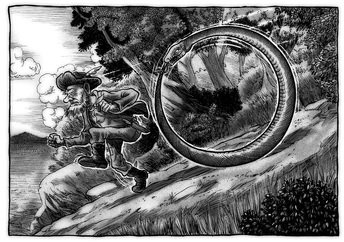Hoop Snake: The Rolling Snake Cryptid

An artist's recreation of a hoop snake encounter. Photo: New Cryptozoology.
A hoop snake is a creature that's said to be able to bite down on its own tail and roll after its prey like a wheel. Hoop snakes have been seen in the USA, Australia and Canada.
Hoop Snake Description

A hoop snake chases Paul Bunyan.
The hoop snake legend centers around a snake that can grab its tail with its mouth and roll after its prey like a wheel, a bit like the ouroboros from Greek mythology or the tsuchinoko from Japan.
Some versions of the story say that right before it strikes, the snake straightens out and stabs its target with its venomous tail, but you can escape by hiding behind a tree. The tree will take the hit and die from the poison instead.
Some claim that the hoop snake can roll at up to 60km per hour. Hoop snakes are said to grow up to 1.5m long and live for around 8 years. They come in a variety of colours ranging from light green to black.
Female hoop snakes are said to seek a new mate each year and lay up to 15 eggs in the spring.
The hoop snake has been part of the Western zeitgeist for a while, going all the way back to a letter from 1784. The author of the letter said that the hoop snake moves like a normal snake most of the time, but when it's chasing after something to eat, it curls up into a hoop and rolls towards its prey with its tail pointed forward, always ready to strike.
It was called the hoop snake after the hoops that children roll around as a toy.
Hoop Snake Sightings
Locals claim that hoop snakes can be found in the caves at Wilsons Prom in Victoria, Australia. They are also said to live near sister’s beach in Tasmania.
In the USA, hoop snakes have purportedly been sighted in the vicinity of the St. Croix River, which flows along the boundary between the states of Minnesota and Wisconsin. This area provides ample aquatic resources for the snake to navigate and conceal itself while pursuing its prey, which unfortunately includes humans.
Hoop snakes have also been reportedly observed farther east in Wake County, North Carolina. The reasons for the distribution of this species across such great distances remain unclear.
Theories about the Hoop Snake
A video about the legend of the Hoop Snake
There have been suggestions put forward by some that the hoop snake is a misrepresented depiction of the sidewinder of the American Southwest or of mud snakes, which have been observed lying in a loosely coiled circular shape on occasion.
It is speculated that the hoop snake may have arisen as a fanciful embellishment of real-life occurrences of snakes consuming their own tails, mistakenly mistaking them for prey.
Do you think the hoop snake is real? Let us know in the comments!
If you enjoyed this article you might also be interested in the tale of the Palmyra Wolves or Tahoe Tessie.





























